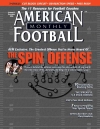AMERICAN FOOTBALL MONTHLY THE #1 RESOURCE FOR FOOTBALL COACHES
Article CategoriesAFM Magazine
|
Point-Counterpoint: The Spread Offense vs. The 3-3 Stack Defenseby: David Purdum© More from this issue South Panola is the only team in its region not using the spread offense. Head coach Ricky Woods says the soggy Mississippi weather is the reason he prefers a power running attack out of the I-formation. But he is well aware of how potent a versatile spread attack can be. “If somebody has a really good running quarterback and a really good running back, it isolates you,” Woods said. “One mistake can cost you a touchdown.” Coach Woods, meet Slidell (LA) offensive coordinator Art Liuzza, a longtime spread believer with a mobile quarterback and powerful running back. These two successful Gulf Coast coaches recently discussed the benefits of the spread offense and how to slow it down in certain game situations.
|
Copyright 2025, AmericanFootballMonthly.com All Rights Reserved | ||||||||||||





